Jaringan
1. Refer to the exhibit. What will router R1 do with a packet that has a destination IPv6 address of 2001:db8:cafe:5::1?
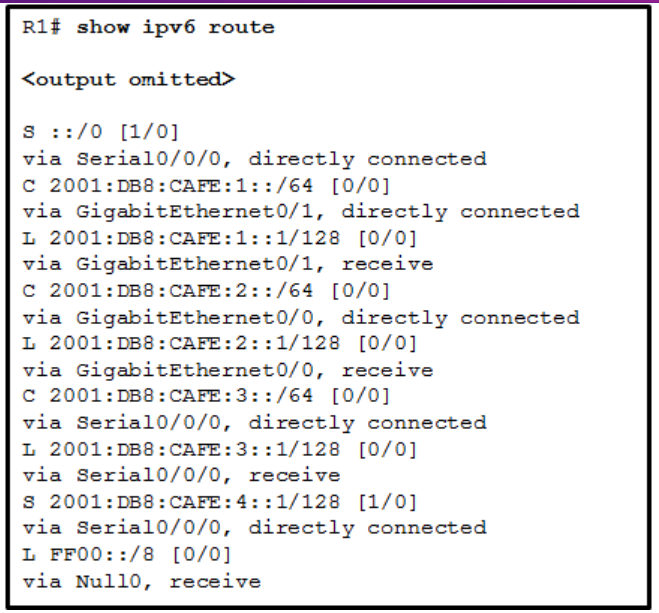
- forward the packet out GigabitEthernet0/0
- drop the packet
- forward the packet out GigabitEthernet0/1
- forward the packet out Serial0/0/0
2. Refer to the exhibit. Currently router R1 uses an EIGRP route learned from Branch2 to reach the 10.10.0.0/16 network. Which floating static route would create a backup route to the 10.10.0.0/16 network in the event that the link between R1 and Branch2 goes down?

- ip route 10.10.0.0 255.255.0.0 Serial 0/0/0 100
- ip route 10.10.0.0 255.255.0.0 209.165.200.226 100
- ip route 10.10.0.0 255.255.0.0 209.165.200.225 100
- ip route 10.10.0.0 255.255.0.0 209.165.200.225 50
3. Refer to the exhibit. R1 was configured with the static route command ip route 209.165.200.224 255.255.255.224 S0/0/0 and consequently users on network 172.16.0.0/16 are unable to reach resources on the Internet. How should this static route be changed to allow user traffic from the LAN to reach the Internet?
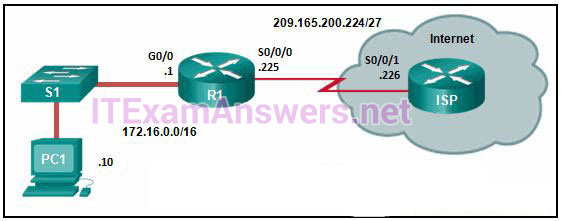
CCNA 2 v7 Switching Routing and Wireless Essentials-Version-Final-Answers-3
- Add an administrative distance of 254.
- Change the destination network and mask to 0.0.0.0 0.0.0.0
- Change the exit interface to S0/0/1.
- Add the next-hop neighbor address of 209.165.200.226.
4. Which option shows a correctly configured IPv4 default static route?
- ip route 0.0.0.0 255.255.255.0 S0/0/0
- ip route 0.0.0.0 0.0.0.0 S0/0/0
- ip route 0.0.0.0 255.255.255.255 S0/0/0
- ip route 0.0.0.0 255.0.0.0 S0/0/0
5. Refer to the exhibit. Which static route command can be entered on R1 to forward traffic to the LAN connected to R2?
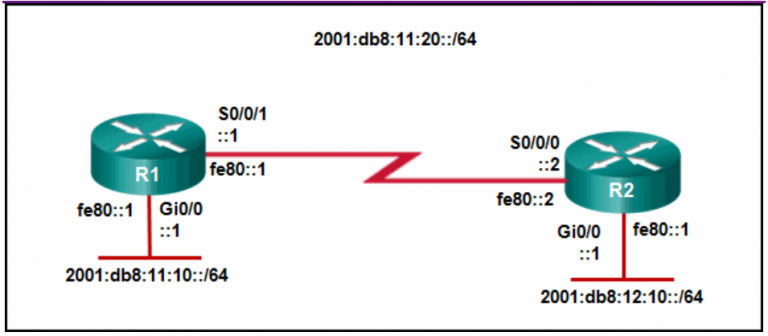
CCNA 2 v7 Switching Routing and Wireless Essentials-Version-Final-Answers-5
- ipv6 route 2001:db8:12:10::/64 S0/0/0
- ipv6 route 2001:db8:12:10::/64 S0/0/1 fe80::2
- ipv6 route 2001:db8:12:10::/64 S0/0/0 fe80::2
- ipv6 route 2001:db8:12:10::/64 S0/0/1 2001:db8:12:10::1
6. What is a method to launch a VLAN hopping attack?
- introducing a rogue switch and enabling trunking
- sending spoofed native VLAN information
- sending spoofed IP addresses from the attacking host
- flooding the switch with MAC addresses
7. A cybersecurity analyst is using the macof tool to evaluate configurations of switches deployed in the backbone network of an organization. Which type of LAN attack is the analyst targeting during this evaluation?
- VLAN hopping
- DHCP spoofing
- MAC address table overflow
- VLAN double-tagging
8. Refer to the exhibit. A network administrator is configuring a router as a DHCPv6 server. The administrator issues a show ipv6 dhcp pool command to verify the configuration. Which statement explains the reason that the number of active clients is 0?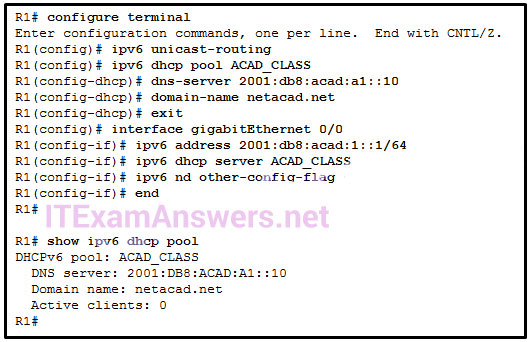
- The default gateway address is not provided in the pool.
- No clients have communicated with the DHCPv6 server yet.
- The IPv6 DHCP pool configuration has no IPv6 address range specified.
- The state is not maintained by the DHCPv6 server under stateless DHCPv6 operation.
9. Refer to the exhibit. A network administrator configured routers R1 and R2 as part of HSRP group 1. After the routers have been reloaded, a user on Host1 complained of lack of connectivity to the Internet The network administrator issued the show standby brief command on both routers to verify the HSRP operations. In addition, the administrator observed the ARP table on Host1. Which entry should be seen in the ARP table on Host1 in order to gain connectivity to the Internet?
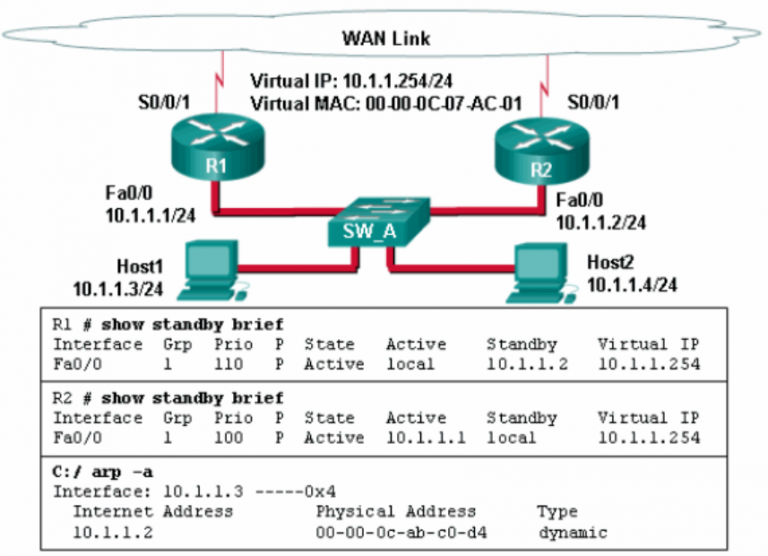
- the virtual IP address and the virtual MAC address for the HSRP group 1
- the virtual IP address of the HSRP group 1 and the MAC address of R1
- the virtual IP address of the HSRP group 1 and the MAC address of R2
10. Match the forwarding characteristic to its type. (Not all options are used.)
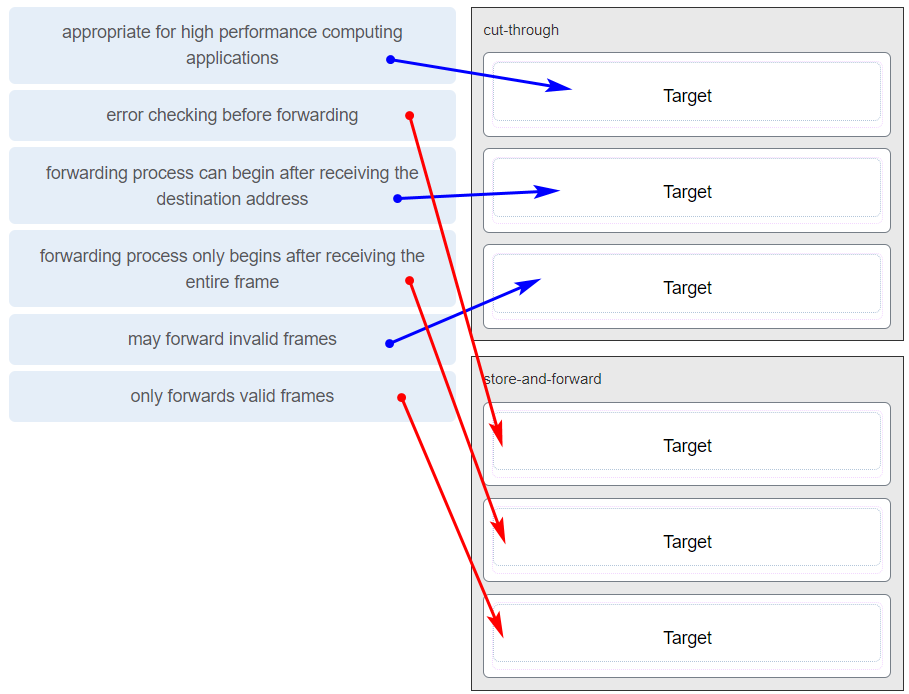
Match the forwarding characteristic to its type. (Not all options are used.)
11. Which statement is correct about how a Layer 2 switch determines how to forward frames?
- Frame forwarding decisions are based on MAC address and port mappings in the CAM table.
- Only frames with a broadcast destination address are forwarded out all active switch ports.
- Cut-through frame forwarding ensures that invalid frames are always dropped.
12. Which statement describes a result after multiple Cisco LAN switches are interconnected?
- The broadcast domain expands to all switches.
- One collision domain exists per switch.
- There is one broadcast domain and one collision domain per switch.
- Frame collisions increase on the segments connecting the switches.
- Unicast frames are always forwarded regardless of the destination MAC address.
13. Match the link state to the interface and protocol status. (Not all options are used.)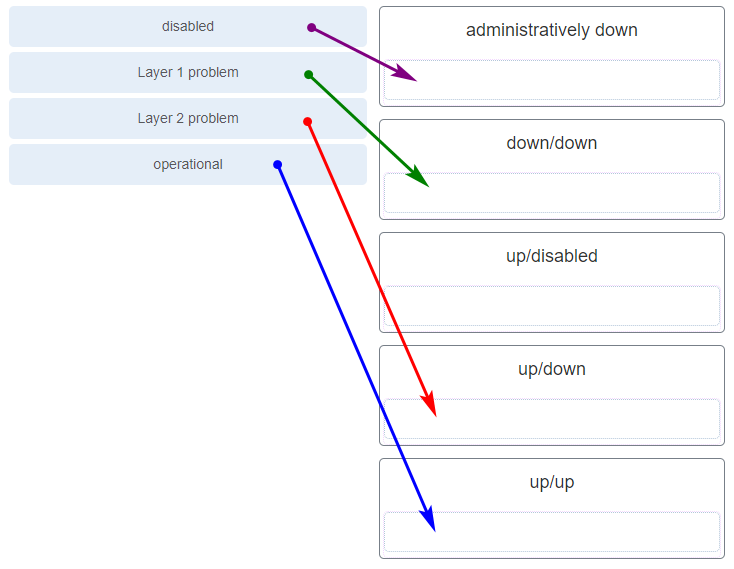
13A. Match the step to each switch boot sequence description. (Not all options are used.)
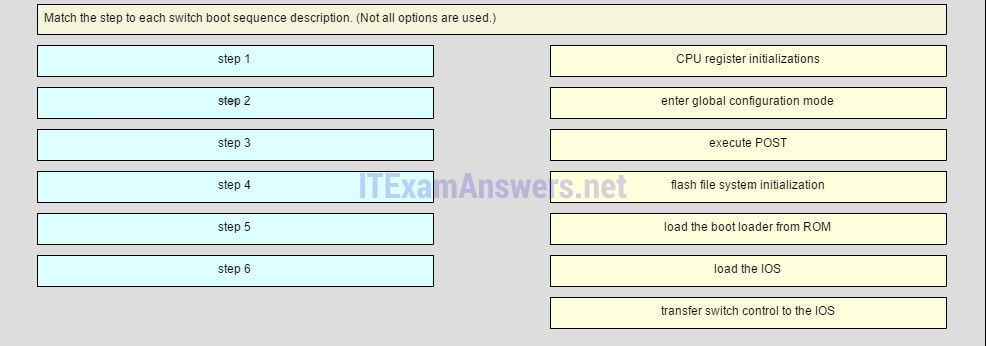
Answer
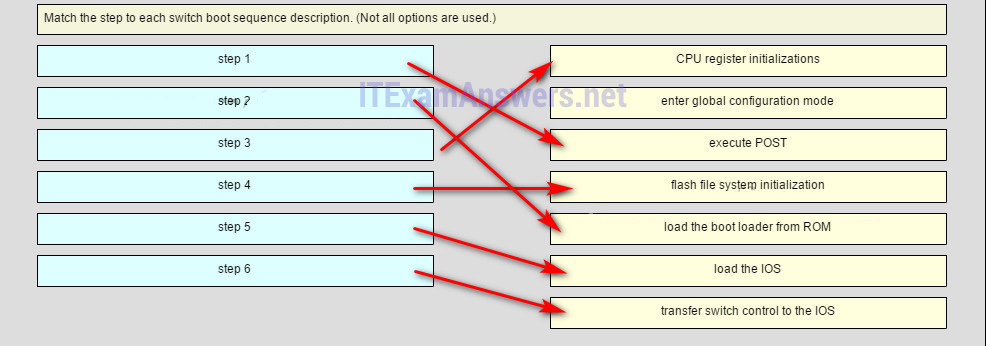
The steps are:
1. execute POST
2. load the boot loader from ROM
3. CPU register initializations
4. flash file system initialization
5. load the IOS
6. transfer switch control to the IOS
14.Refer to the exhibit. How is a frame sent from PCA forwarded to PCC if the MAC address table on switch SW1 is empty?
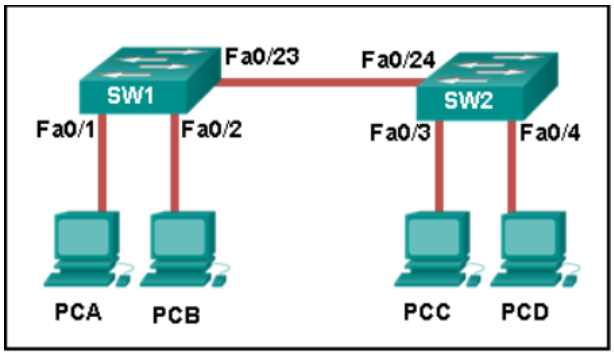
- SW1 forwards the frame directly to SW2. SW2 floods the frame to all ports connected to SW2, excluding the port through which the frame entered the switch.
- SW1 floods the frame on all ports on the switch, excluding the interconnected port to switch SW2 and the port through which the frame entered the switch.
- SW1 floods the frame on all ports on SW1, excluding the port through which the frame entered the switch.
- SW1 drops the frame because it does not know the destination MAC address.
15. An administrator is trying to remove configurations from a switch. After using the command erase startup-config and reloading the switch, the administrator finds that VLANs 10 and 100 still exist on the switch. Why were these VLANs not removed?
- Because these VLANs are stored in a file that is called vlan.dat that is located in flash memory, this file must be manually deleted.
- These VLANs cannot be deleted unless the switch is in VTP client mode.
- These VLANs are default VLANs that cannot be removed.
- These VLANs can only be removed from the switch by using the no vlan 10 and no vlan 100 commands.
16. Match the description to the correct VLAN type. (Not all options are used.)
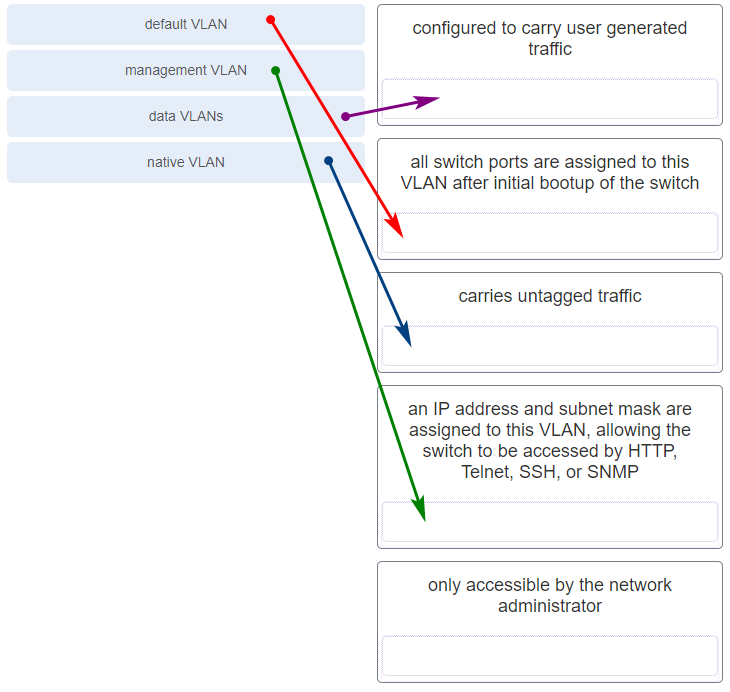
17. Refer to the exhibit. A network administrator has connected two switches together using EtherChannel technology. If STP is running, what will be the end result?
- STP will block one of the redundant links.
- The switches will load balance and utilize both EtherChannels to forward packets.
- The resulting loop will create a broadcast storm.
- Both port channels will shutdown.
18. What is a secure configuration option for remote access to a network device?
- Configure an ACL and apply it to the VTY lines.
- Configure 802.1x.
- Configure SSH.
- Configure Telnet.
19. Which wireless encryption method is the most secure?
- WPA2 with AES
- WPA2 with TKIP
- WEP
- WPA
20. After attaching four PCs to the switch ports, configuring the SSID and setting authentication properties for a small office network, a technician successfully tests the connectivity of all PCs that are connected to the switch and WLAN. A firewall is then configured on the device prior to connecting it to the Internet. What type of network device includes all of the described features?
- firewall appliance
- wireless router
- switch
- standalone wireless access point
21. Refer to the exhibit. Host A has sent a packet to host B. What will be the source MAC and IP addresses on the packet when it arrives at host B?

CCNA 2 v7 Switching Routing and Wireless Essentials-Version-Final-Answers-21
- Source MAC: 00E0.FE91.7799
Source IP: 10.1.1.10 - Source MAC: 00E0.FE10.17A3
Source IP: 10.1.1.10 - Source MAC: 00E0.FE10.17A3
Source IP: 192.168.1.1 - Source MAC: 00E0.FE91.7799
Source IP: 10.1.1.1 - Source MAC: 00E0.FE91.7799
Source IP: 192.168.1.1
22. Refer to the exhibit. Which static route would an IT technician enter to create a backup route to the 172.16.1.0 network that is only used if the primary RIP learned route fails?
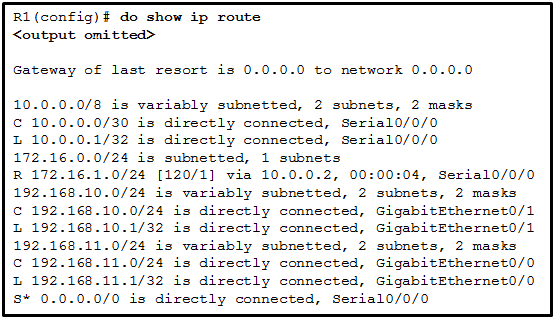
CCNA 2 v7 Switching Routing and Wireless Essentials-Version-Final-Answers-22
- ip route 172.16.1.0 255.255.255.0 s0/0/0
- ip route 172.16.1.0 255.255.255.0 s0/0/0 91
- ip route 172.16.1.0 255.255.255.0 s0/0/0 121
- ip route 172.16.1.0 255.255.255.0 s0/0/0 111
23. Refer to the exhibit. In addition to static routes directing traffic to networks 10.10.0.0/16 and 10.20.0.0/16, Router HQ is also configured with the following command:
ip route 0.0.0.0 0.0.0.0 serial 0/1/1
What is the purpose of this command?
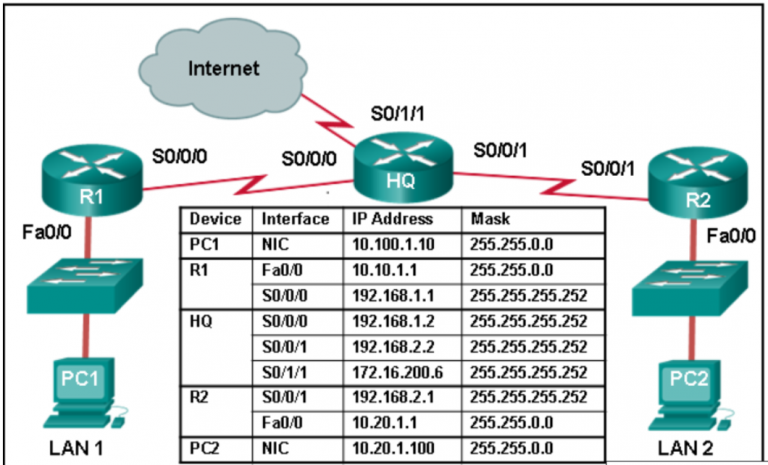
CCNA 2 v7 Switching Routing and Wireless Essentials-Version-Final-Answers-23
- Packets that are received from the Internet will be forwarded to one of the LANs connected to R1 or R2.
- Packets with a destination network that is not 10.10.0.0/16 or is not 10.20.0.0/16 or is not a directly connected network will be forwarded to the Internet.
- Packets from the 10.10.0.0/16 network will be forwarded to network 10.20.0.0/16, and packets from the 10.20.0.0/16 network will be forwarded to network 10.10.0.0/16.
- Packets that are destined for networks that are not in the routing table of HQ will be dropped.
24. What protocol or technology disables redundant paths to eliminate Layer 2 loops?
- VTP
- STP
- EtherChannel
- DTP
25. Refer to the exhibit. Based on the exhibited configuration and output, why is VLAN 99 missing?
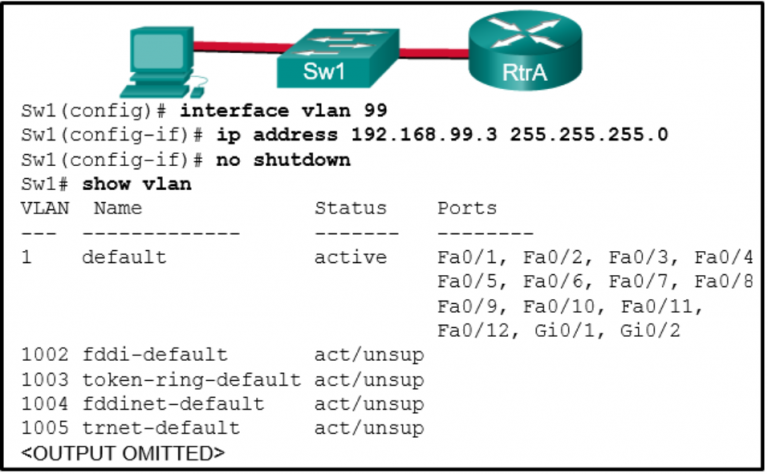
CCNA 2 v7 Switching Routing and Wireless Essentials-Version-Final-Answers-25
- because VLAN 99 is not a valid management VLAN
- because there is a cabling problem on VLAN 99
- because VLAN 1 is up and there can only be one management VLAN on the switch
- because VLAN 99 has not yet been created
26. Which two VTP modes allow for the creation, modification, and deletion of VLANs on the local switch? (Choose two.)
- client
- master
- distribution
- slave
- server
- transparent
27. Which three steps should be taken before moving a Cisco switch to a new VTP management domain? (Choose three.)
- Configure the switch with the name of the new management domain.
- Reset the VTP counters to allow the switch to synchronize with the other switches in the domain.
- Configure the VTP server in the domain to recognize the BID of the new switch.
- Download the VTP database from the VTP server in the new domain.
- Select the correct VTP mode and version.
- Reboot the switch.
28. A network administrator is preparing the implementation of Rapid PVST+ on a production network. How are the Rapid PVST+ link types determined on the switch interfaces?
- Link types can only be configured on access ports configured with a single VLAN.
- Link types can only be determined if PortFast has been configured.
- Link types are determined automatically.
- Link types must be configured with specific port configuration commands.
29. Refer to the exhibit. All the displayed switches are Cisco 2960 switches with the same default priority and operating at the same bandwidth. Which three ports will be STP designated ports? (Choose three.)

CCNA 2 v7 Switching Routing and Wireless Essentials-Version-Final-Answers-29
- fa0/9
- fa0/13
- fa0/10
- fa0/20
- fa0/21
- fa0/11
30. How will a router handle static routing differently if Cisco Express Forwarding is disabled?
- It will not perform recursive lookups.
- Ethernet multiaccess interfaces will require fully specified static routes to avoid routing inconsistencies.
- Static routes that use an exit interface will be unnecessary.
- Serial point-to-point interfaces will require fully specified static routes to avoid routing inconsistencies.
31. Compared with dynamic routes, what are two advantages of using static routes on a router? (Choose two.)
- They improve network security.
- They take less time to converge when the network topology changes.
- They improve the efficiency of discovering neighboring networks.
- They use fewer router resources.
32. Refer to the exhibit. Which route was configured as a static route to a specific network using the next-hop address?
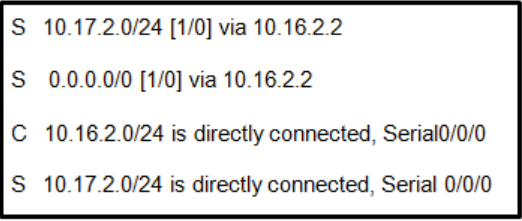
- S 10.17.2.0/24 [1/0] via 10.16.2.2
- S 0.0.0.0/0 [1/0] via 10.16.2.2
- S 10.17.2.0/24 is directly connected, Serial 0/0/0
- C 10.16.2.0/24 is directly connected, Serial0/0/0
33. What is the effect of entering the spanning-tree portfast configuration command on a switch?
- It disables an unused port.
- It disables all trunk ports.
- It enables portfast on a specific switch interface.
- It checks the source L2 address in the Ethernet header against the sender L2 address in the ARP body.
34. What is the IPv6 prefix that is used for link-local addresses?
- FF01::/8
- 2001::/3
- FC00::/7
- FE80::/10
35. Which two statements are characteristics of routed ports on a multilayer switch? (Choose two.)
- In a switched network, they are mostly configured between switches at the core and distribution layers.
- The interface vlan command has to be entered to create a VLAN on routed ports.
- They support subinterfaces, like interfaces on the Cisco IOS routers.
- They are used for point-to-multipoint links.
- They are not associated with a particular VLAN.
36. Successful inter-VLAN routing has been operating on a network with multiple VLANs across multiple switches for some time. When an inter-switch trunk link fails and Spanning Tree Protocol brings up a backup trunk link, it is reported that hosts on two VLANs can access some, but not all the network resources that could be accessed previously. Hosts on all other VLANS do not have this problem. What is the most likely cause of this problem?
- The protected edge port function on the backup trunk interfaces has been disabled.
- The allowed VLANs on the backup link were not configured correctly.
- Dynamic Trunking Protocol on the link has failed.
- Inter-VLAN routing also failed when the trunk link failed.
37. Which command will start the process to bundle two physical interfaces to create an EtherChannel group via LACP?
- interface port-channel 2
- channel-group 1 mode desirable
- interface range GigabitEthernet 0/4 – 5
- channel-group 2 mode auto
38. What action takes place when a frame entering a switch has a multicast destination MAC address?
- The switch will forward the frame out all ports except the incoming port.
- The switch forwards the frame out of the specified port.
- The switch adds a MAC address table entry mapping for the destination MAC address and the ingress port.
- The switch replaces the old entry and uses the more current port.
39. A junior technician was adding a route to a LAN router. A traceroute to a device on the new network revealed a wrong path and unreachable status. What should be done or checked?
- Verify that there is not a default route in any of the edge router routing tables.
- Check the configuration on the floating static route and adjust the AD.
- Create a floating static route to that network.
- Check the configuration of the exit interface on the new static route.
40. Select the three PAgP channel establishment modes. (Choose three.)
- auto
- default
- passive
- desirable
- extended
- on

Komentar